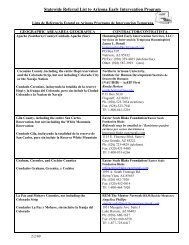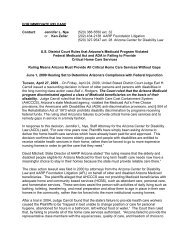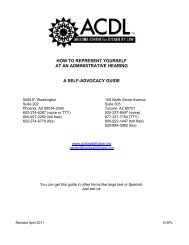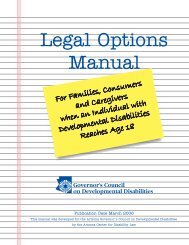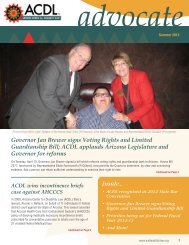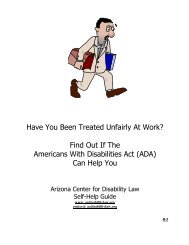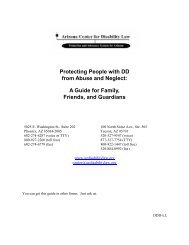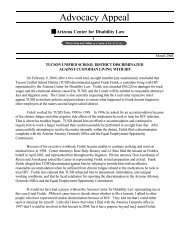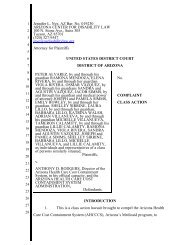How to Enforce Employment Rights Under the Americans with ...
How to Enforce Employment Rights Under the Americans with ...
How to Enforce Employment Rights Under the Americans with ...
Create successful ePaper yourself
Turn your PDF publications into a flip-book with our unique Google optimized e-Paper software.
$ seeing $ hearing $ walking$ working $ learning $ thinking$ reading $ lifting $ concentrating$ reproducing $ interacting <strong>with</strong> $ sleepingo<strong>the</strong>rs$ performing manual tasks in certain situations$ engaging in sexual relations(2) a his<strong>to</strong>ry of a substantially limiting impairment, or(3) being regarded as having a substantially limiting impairment.<strong>How</strong>ever, persons who are currently illegally using drugs are generally not considereddisabled because of <strong>the</strong>ir drug use. A person is qualified under <strong>the</strong> ADA if s/he has all of <strong>the</strong>skills, education, and experience required for <strong>the</strong> position and is able <strong>to</strong> perform <strong>the</strong> essentialfunctions of <strong>the</strong> job <strong>with</strong> or <strong>with</strong>out reasonable accommodations. For more information aboutwhat <strong>the</strong>se special terms mean, see <strong>the</strong> Center's guide, An Overview of <strong>the</strong> <strong>Employment</strong> Protectionsof <strong>the</strong> ADA.B. The Equal <strong>Employment</strong> Opportunity Commission1. Introduction <strong>to</strong> <strong>the</strong> EEOCThe EEOC is a federal agency <strong>with</strong> <strong>the</strong> responsibility <strong>to</strong> enforce <strong>the</strong> employment provisionsof <strong>the</strong> ADA (Title I). 1 This responsibility includes taking charges (or complaints ofdiscrimination) from people who believe that <strong>the</strong>y have been discriminated against in employmen<strong>to</strong>n <strong>the</strong> basis of a disability, investigating those complaints, making a determination of whe<strong>the</strong>r<strong>the</strong>re is reasonable cause <strong>to</strong> believe that discrimination occurred, and issuing Notices of Right <strong>to</strong>Sue (also called “right <strong>to</strong> sue” letters).The EEOC will also attempt <strong>to</strong> work out an agreement - sometimes called a "settlement" -between <strong>the</strong> parties <strong>to</strong> resolve <strong>the</strong> claim of discrimination if that is possible. Once a finding of1 The ADA prohibits discrimination in areas o<strong>the</strong>r than employment. For example, discrimination inpublic accommodations such as restaurants and movie <strong>the</strong>aters is prohibited. O<strong>the</strong>r agencies are charged<strong>with</strong> enforcing <strong>the</strong> non-employment provisions of <strong>the</strong> ADA. For example, <strong>the</strong> Department of Justiceinvestigates complaints of discrimination in public accommodations. For more information aboutcomplaint procedures for violations of o<strong>the</strong>r provisions of <strong>the</strong> ADA, contact <strong>the</strong> staff at <strong>the</strong> ACDL.5




